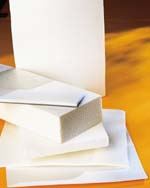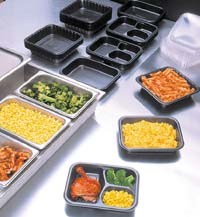Foamed PET Sheet Tackles New Markets
Perpetually in its infancy, PET foam sheet has been a hard sell for packaging producers over nearly a decade. It found successful niches in thermoformed ovenable bakery trays, meat trays, and reheatable dinner trays for home delivery to disabled persons.
Perpetually in its infancy, PET foam sheet has been a hard sell for packaging producers over nearly a decade. It found successful niches in thermoformed ovenable bakery trays, meat trays, and reheatable dinner trays for home delivery to disabled persons. But since the early 1990s, probably no more than a half-dozen processors globally have actually been able to make the sheet commercially—and some of those later quit. The two stumbling points have been the difficulty of foaming PET into consistent sheet product, as well as the difficulty and cost of reusing the copious foamed scrap left from thermoforming.
Now, for the first time in years, new foamed PET products are in R&D, including thicker sheet with higher densities and thinner films with very low densities. Developmental applications are being explored in new non-packaging markets such as automotive, building construction, and defense.
“High-temperature pipe insulation and sound and heat insulation in automotive are some of the potential uses,” says Gary Boone, senior technical-service representative for Eastman Chemical Co., Kingsport, Tenn. Eastman makes a reactive additive, Eastolite E3031-92AA, that increases the melt strength of PET to help facilitate foaming.
Early problems
The first commercial U.S. product was a foamed CPET cake pan made in 1993 by Ultra Pac (now Ivex Ultra Pac) in Rogers, Minn., using high-I.V. Petlite resin from Shell Chemical Co. on a Welex single-screw extruder. But Ultra Pac’s foamed pans were discontinued two years later.
The difficulty was the cost of reprocessing the foamed scrap, which amounted to about 50% of the initial sheet after thermoforming. Even after densifying and repelletizing, the foam scrap still bubbled when re-extruded. Houston-based Mossi & Ghisolfi later bought Shell’s PET business and dropped Shell’s Petlite resin in favor of M&G’s own high-I.V. PET, called Cobifoam.
Today, the only known commercial foamer of PET in the U.S. is Genpak LLC in Lancaster, S.C., which commercialized foamed PET in 1998 after five years of R&D. Genpak makes foamed ovenable CPET bakery trays, meat trays, and multi-compartment trays for home-delivery meals. Trademarked PET+, the trays range in density from 0.15 to 0.35 g/cc. Genpak is now also developing very low-density foams for durable applications such as automotive parts.
Genpak patented the use of heptane as a blowing agent because its high boiling temperature creates gas pressure at PET’s processing temperature of 480 F that matches typical blowing pressures for PS. On the other hand, nitrogen and CO2 create excessively high pressure at the die, Genpak found, causing foam corrugation and poor surface quality.
Genpak is able to reprocess foam scrap by using Eastolite E3031-92AA reactive chain extender, or “branching agent,” to restore the resin’s original I.V.
Durables in R&D
“We’re looking for a lot of automotive applications for foamed PET,” says John Bambara, president and CEO of Sentinel Products Corp., Hyannis, Mass., which has worked for 18 months on a range of new PET foams. “We have eight or nine companies with secrecy agreements on PET foam. One major durable application for PET foam in development is thermoformed automotive headliners.” For this application, Sentinel is developing 0.2-in.-thick sheet of 0.141 g/cc density. It’s being tested by companies in Europe and Asia, Sentinel says.
Sentinel makes developmental PET foams from 0.007 in. up to 0.2 in. thick on a Davis-Standard twin-screw extruder with an annular die. Foamed PET samples thicker than 0.2 in. are being made for Sentinel by a European company. Very thin (0.007-0.008 in.) foam sheet is printable and acts as a barrier to most chemicals. “Some of the applications for this are gigantic—such as envelope liners and labels,” says Bambara. One patent-pending barrier application for foamed PET sheet has a density as low as 0.05 g/cc and only 0.2-mm cell size.
Sentinel’s PET foam technology uses a reactive additive to crosslink PET slightly, raising its melt strength and binding additives and other polymers into the PET. “With PET foam we only crosslink a little bit,” Bambara notes. Sentinel blows the foam with a blend of CO2, nitrogen, and other gases. Sentinel offers to sell a gas feeding and blending device to other foamers.
Sentinel also has applied for patents on technologies for thermoforming thicker foams. Sentinel is working with Irwin Research & Development Inc. in Yakima, Wash., to develop the thermoforming equipment. Meanwhile, M&G’s lab in Akron, Ohio, is beginning to develop data on the strength of PET foams at different thicknesses and densities to characterize foamable grades.
European developments
While all commercially foamed PET in the U.S. uses physical blowing agents, most commercial foamed PET in Europe currently uses chemical blowing agents (CBAs). Chemical agents typically lower PET’s density by only 40-50% to around 0.7-0.8 g/cc. CBAs may also hurt the recyclability of scrap. If too much CBA concentrate is used, undecomposed foaming agent will affect later processing. Some European foam-sheet scrap is not reused but is sold to makers of PET fiberfill.
R&D on thick PET foam sheet is being done by BC Foam srl in Volpiano, Italy, a recently established maker of corotating twin-screw extruders. BC Foam, which was formed by former principals of LMP Impianti, has produced commercial quantities of thermoformable PET sheet using annular dies and has also extruded PET foam boards up to 2.5 in. thick from flat dies. BC Foam expects to make foams up to 4 in. thick and with densities as low as 0.047 g/cc. One foam board in development for a military application is of 0.376 g/cc density.
Thick foams present difficulties in cooling and maintaining uniform bubble distribution. Thick foam leaves the die hotter than 390 F, then cools very fast on the outside but very slowly inside.
BC Foam has just built its first twin-screw line for foamed PET sheet. The system can use a variety of blowing agents, including nitrogen, CO2, HFC-134, or HFC-152. “Commercial activities in Europe and Asia for industrial applications are at an advanced stage,” says Alberto Bruschieri, technical director.
European packaging processors also make thinner foamed PET (both APET and CPET) for laminating with a five-layer coex film or extrusion coating with a six-layer barrier. The resulting seven-layer structure of PET foam-tie-PE-tie-EVOH-tie-PE is typically 13.8 to 19.7 mils thick and reduces cost and weight in thermoformed meat trays for modified-atmosphere packaging. Commercial processors include Akerlund & Rausing in Sweden and Wihuri Wipak in Finland. BP Chemicals PlasTec GmbH in Germany is performing foamed CPET trials and should have a commercial product in six months.
Related Content
Extrusion Excellence: This Year's Top Stories
Revisit the year’s most popular articles on extrusion technology and processes, showcasing innovations, best practices, and the trends that captured the plastics processing community’s attention.
Read MoreHow to Decrease the Extrudate Temperature in Single-Screw Extruders
In many cases, decreasing the discharge temperature will improve product quality and perhaps even boost rate. Here are ways to do it.
Read MoreHow to Effectively Reduce Costs with Smart Auxiliaries Technology
As drying, blending and conveying technologies grow more sophisticated, they offer processors great opportunities to reduce cost through better energy efficiency, smaller equipment footprints, reduced scrap and quicker changeovers. Increased throughput and better utilization of primary processing equipment and manpower are the results.
Read MoreBrewer Chooses Quick-Change Flexibility to Blow Wide Range of PET Beer Bottles
Beermaster Brewery found a “universal” stretch-blow machine from PET Technologies enables multiple changes per day among four sizes of beer bottles.
Read MoreRead Next
See Recyclers Close the Loop on Trade Show Production Scrap at NPE2024
A collaboration between show organizer PLASTICS, recycler CPR and size reduction experts WEIMA and Conair recovered and recycled all production scrap at NPE2024.
Read MoreFor PLASTICS' CEO Seaholm, NPE to Shine Light on Sustainability Successes
With advocacy, communication and sustainability as three main pillars, Seaholm leads a trade association to NPE that ‘is more active today than we have ever been.’
Read MoreBeyond Prototypes: 8 Ways the Plastics Industry Is Using 3D Printing
Plastics processors are finding applications for 3D printing around the plant and across the supply chain. Here are 8 examples to look for at NPE2024.
Read More























